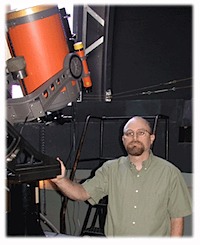Associate Professor
Director of Astronomical Facilities
Office: LSC 012
Telephone: 501.450.5907
FAX: 501.852.2286
E-Mail: saustin@uca.edu

Education: PhD., Physics, Arizona State University (1995)
Research: Variable stars, spectroscopy, photometry, asteroid astrometry.
Recent Publications:
Member:
Astronomical Society of the Pacific
American Association of Physics Teachers
International Dark-Sky Association
Southwest Association of Planetariums
Professional Biography:
Scott Austin was born on November 13, 1965 in Michigan. He became interested in science and astronomy in 5th grade, and graduated from Durand Area High School in 1983. He majored in physics at Michigan State University, was an undergraduate teaching assistant for physics courses in the Lyman Briggs College at MSU, and was an undergraduate research assistant at the MSU National Superconducting Cyclotron Laboratory analyzing streamer chamber data. After completing a B.S. in physics in 1987, he moved to Tempe Arizona to pursue a graduate degree at Arizona State University. While at ASU Scott did research in the area of astronomy and astrophysics doing observational and computational work primarily on classical novae. Classical novae are thermonuclear explosions of the hydrogen-rich material accreted onto a white dwarf from a close companion star. The work he did on Nova Cygnii 1992 became his dissertation and publication in the Astronomical Journal. This graduate work included using telescopes at major observatories in Arizona (Steward Observatory 2.3-m Bok telescope on Kitt Peak, the Multiple-Mirror Telescope on Mount Hopkins, and the 1.8-m Perkins telescope of Lowell Observatory at Anderson Mesa), and data from space-based telescopes (International Ultraviolet Explorer and Hubble Space Telescope). After a successful PhD. defense in 1995, Scott had a one year lectureship at Penn State Erie, and a two-year visiting assistant professor position at Washington State University in Pullman Washington. While at WSU Scott was also the director of the WSU Planetarium and the WSU Observatory. The position at WSU also allowed him to observe with the Apache Point 3.5-m telescope in New Mexico. Scott took his current position at the University of Central Arkansas in the Department of Physics and Astronomy starting in the fall of 2000 and was granted tenure in the spring of 2006. His teaching duties have included lower division astronomy courses and upper division physics courses. He has renovated the UCA Observatory so that a variety of research projects are being done with the new 0.35-m telescope. These projects include near-earth asteroid astrometry, emission star spectroscopy, and variable-star time-series-photometry. He also does research using the Indiana University 1.25-m Spectrabot telescope, 0.6-m telescope at the private Nubbin Ridge Observatory run by Jim Hoskins near Hot Springs, and with the McDonald Observatory 10-m Hobby-Eberly telescope in Texas. Scott does public outreach with the UCA Observatory and the 60-seat UCA Planetarium. He runs monthly public viewing nights with the observatory. With the planetarium he produces and gives shows monthly for the general public and by request for school groups.
